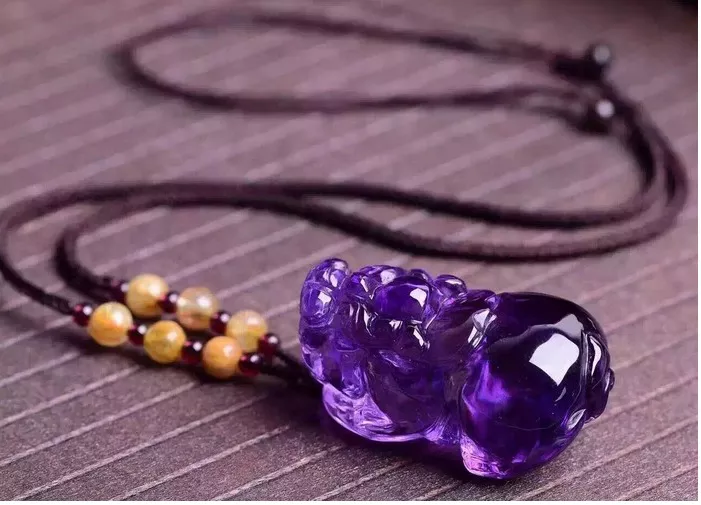Amethyst, a captivating gem cherished for its mesmerizing purple hue, stands as a prominent member of the quartz family. Classified as a variety of quartz, it boasts a unique coloration owed to the presence of iron impurities within its crystalline structure. Fundamentally, amethyst comprises silicon dioxide, the chemical composition shared by all quartz varieties. What sets amethyst apart is its distinct purple color, a result of irradiation and the incorporation of trace elements during its formation.
The crystalline nature of amethyst is pivotal to its identity. Crystallinity denotes an ordered atomic arrangement, which amethyst proudly exhibits. Within its crystalline lattice, silicon and oxygen atoms arrange themselves in a precise, repeating pattern, bestowing amethyst with its characteristic properties and allure.
Stone vs. Crystal:
To unravel the discourse surrounding amethyst, it’s imperative to address the distinction between “stone” and “crystal.” In the realm of gemology, the term “stone” often serves as an umbrella designation encompassing various minerals, gems, and crystalline formations. Amethyst, unequivocally a crystal, aligns with the crystalline subset of stones, owing to its ordered atomic structure and well-defined crystalline form.
Unlike non-crystalline rocks, which lack a distinct atomic arrangement, amethyst embodies crystallinity, manifesting in its striking geometric facets and symmetrical growth patterns. Thus, while colloquially referred to as a “stone,” amethyst unequivocally qualifies as a crystal, adhering to the stringent criteria dictated by crystallography.
Crystal Properties:
Beyond its geological composition, amethyst is revered for its multifaceted metaphysical properties. Renowned for its soothing energy and spiritual resonance, amethyst transcends its earthly origins, fostering a profound connection with the metaphysical realm. As a stalwart companion in meditation and energy work, amethyst channels tranquility and clarity, guiding practitioners on an introspective journey of self-discovery and enlightenment.
The metaphysical allure of amethyst extends beyond its calming influence, delving into realms of intuition and spiritual insight. Believed to enhance psychic abilities and stimulate the third eye chakra, amethyst serves as a conduit for spiritual enlightenment and heightened consciousness. Its ethereal energy envelops the spirit, fostering a harmonious balance between mind, body, and soul.
Formation:
The genesis of amethyst traces back to ancient geological processes, wherein crystalline formations emerge within geodes or cavities nestled within volcanic rocks. As magma cools and solidifies, it creates pockets of space within the rock matrix, providing an ideal environment for crystal growth. Within these enclaves, amethyst crystals gradually take shape, their majestic structures unfurling amidst a backdrop of molten earth.
The vibrant purple hues synonymous with amethyst arise from a delicate interplay of geological factors. Iron impurities imbue the crystal lattice with hues ranging from delicate lavender to regal violet, while natural irradiation during the crystal’s growth amplifies its enchanting color palette. Each amethyst crystal serves as a testament to the geological forces at play, capturing the essence of Earth’s tumultuous evolution within its crystalline embrace.
Variations and Grades:
Amethyst’s allure transcends its uniform purple hue, encompassing a spectrum of shades and qualities. From delicate pastel tones to deep, saturated violets, amethyst exhibits unparalleled diversity within its color palette. The quality of an amethyst specimen is intricately tied to factors such as color intensity, transparency, and clarity, which collectively determine its grading.
High-grade amethyst exemplifies unparalleled clarity and brilliance, with hues that exude richness and depth. Such specimens command admiration for their pristine beauty and exceptional quality. Conversely, lower-grade amethyst may display variations in color saturation and clarity, yet retains its inherent charm and allure.
Jewelry and Decorative Use:
Amethyst’s exquisite beauty has long captivated the hearts of artisans and enthusiasts alike, earning it a coveted place in jewelry and decorative arts. Its regal purple hue adds a touch of sophistication to any piece, making it a popular choice for a wide range of adornments.
In the realm of jewelry, amethyst reigns supreme, adorning rings, necklaces, earrings, and more with its radiant presence. Whether showcased as a dazzling centerpiece or accentuating the brilliance of other gemstones, amethyst lends an air of elegance and refinement to any ensemble.
Beyond jewelry, amethyst finds its place in the realm of decorative arts, gracing interiors with its ethereal beauty. Amethyst geode slices and clusters, with their intricate crystalline formations and vibrant hues, serve as striking accents in home decor. Whether adorning mantelpieces, shelves, or display cabinets, these natural wonders add a touch of enchantment to any space.
In conclusion, amethyst emerges as a quintessential crystalline gem, revered for its resplendent beauty and metaphysical allure. As a stalwart companion in spiritual practice and self-discovery, amethyst transcends its earthly origins, serving as a conduit for enlightenment and spiritual transformation. From its genesis within volcanic geodes to its myriad hues and qualities, amethyst captivates the imagination, inviting us to delve deeper into the enigmatic realm of crystal healing and metaphysical exploration.


